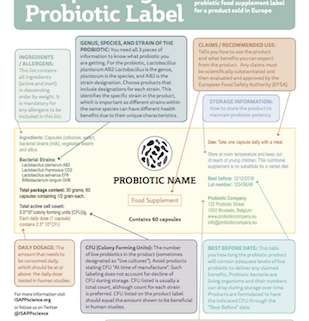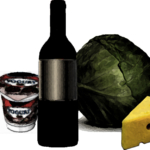New ISAPP infographic on EU probiotic labeling
March 20, 2017. Probiotic Product Labels in the European Union
Understanding the information that is – and isn’t – on a probiotic product label can be difficult. ISAPP created an infographic to help understand the information on the label of a dietary supplement probiotic product. Different regions around the world have different regulatory labeling requirements for probiotic products. See here for an example of a product sold in the United States. This infographic featured on this page, ‘Deciphering a Probiotic Product Label: EU Version’, shows an example of a probiotic food supplement that would be marketed in the European Union (EU). However, even within the EU, different countries differ with regard to label requirements.
Probiotic product labels lack information about what health benefits are associated with the product. This is due to a combination of regulatory restrictions and scientific limitations. For the probiotics sold as nutritional supplements in the EU, all health claims are assessed by the European Food and Safety Authority (EFSA). Furthermore each European country has its own country-specific rules. As of today, no health claims for probiotics have been approved by EFSA, and therefore, labels typically contain little or no description of what benefits you can expect from the probiotic. Some European countries cannot even put the word ‘probiotic’ on a product label.
However, this does not mean that evidence for probiotic benefits is necessarily lacking. (See here for more details about probiotics and their associated health benefits.) But it can mean that products containing probiotic strains that have been extensively studied cannot communicate the health benefits because of regulatory restrictions. For example, the types of studies conducted, the populations of people studied or the endpoints of the research may not meet regulatory guidelines. On the other hand, some commercial products may not have been evaluated in controlled human studies. Today’s EU labels do not allow distinguishing between these two extremes. EU probiotic product labeling does not give consumers enough information to determine the best products for their needs. To help with this situation, companies sometimes provide information to the extent allowed by law through the use of third party channels such as independent scientists, healthcare professionals, or clinical organizations. Thus, European consumers must rely on their own research into products in addition to information from their healthcare professionals.
The use of probiotic products for specific consumer or patient groups requires assessment by professionals. It is therefore advised to always consult your physician or health care provider to decide if a specific probiotic product may be beneficial for you.
According to the FAO/WHO 2002 Working Group on Guidelines for the Evaluation of Probiotics in Food (page 39 of this combined document), the following information should be on a probiotic label:
- Genus, species and strain designation for each probiotic strain in the product.
- Minimum viable numbers of each probiotic strain at the end of the shelf-life, typically expressed in colony forming units (cfu). (Note: in practice, products often give a total count for all strains combined. In this case it is not possible to know if all strains in a product are at roughly the same level or at very different levels.)
- The suggested serving size (or dose) must deliver the effective dose of probiotics related to any health benefit communicated on the label.
- Health claim(s) (as allowed by law and substantiated by studies)
- Proper storage conditions
- Corporate contact details for consumer information
These principles were reiterated in ‘Best Practices Guidelines for Probiotics’ (2017) developed by the Council for Responsible Nutrition (CRN). Neither the FAO/WHO nor the CRN guidelines carry the force of law.
See related infographics:







